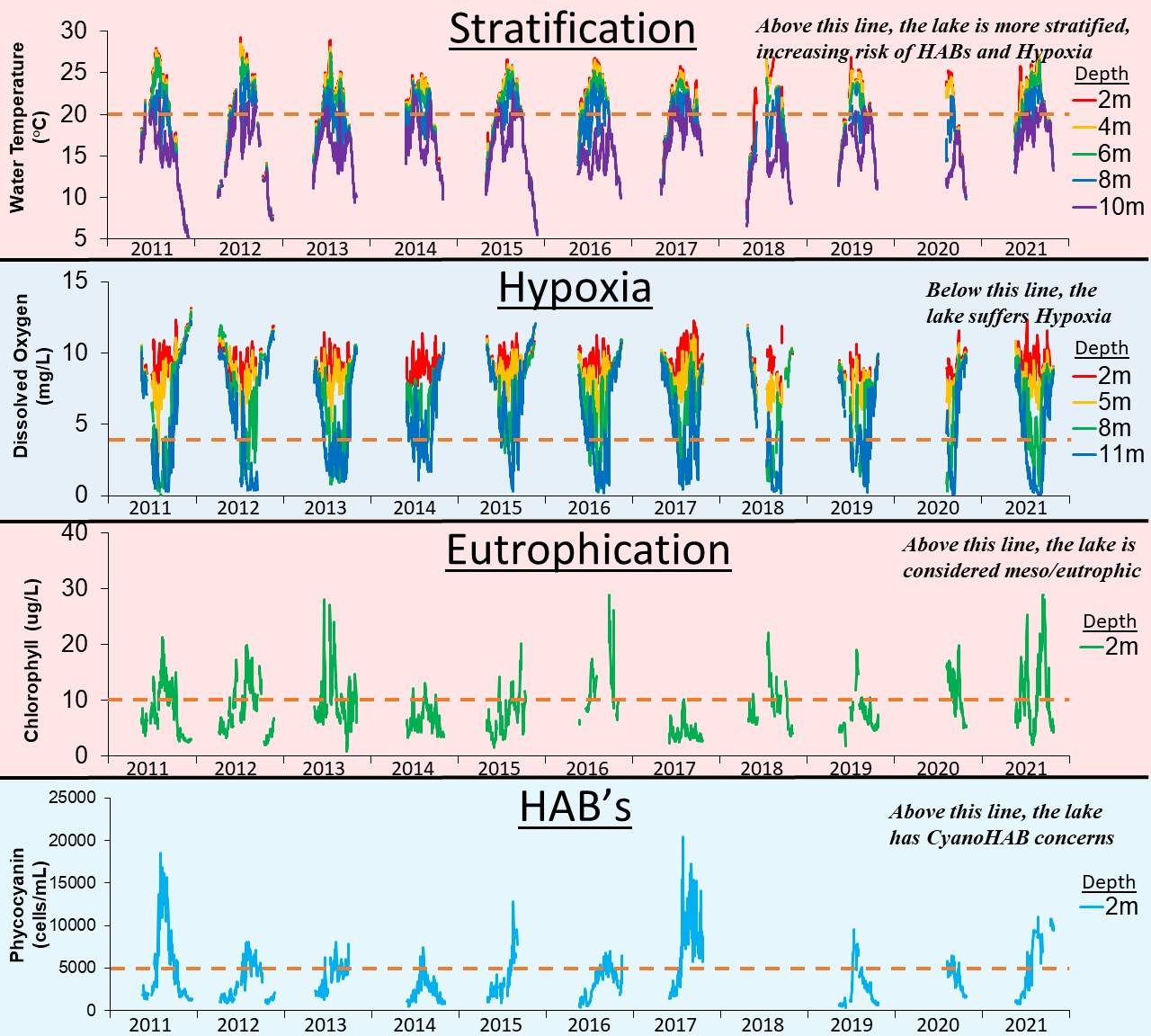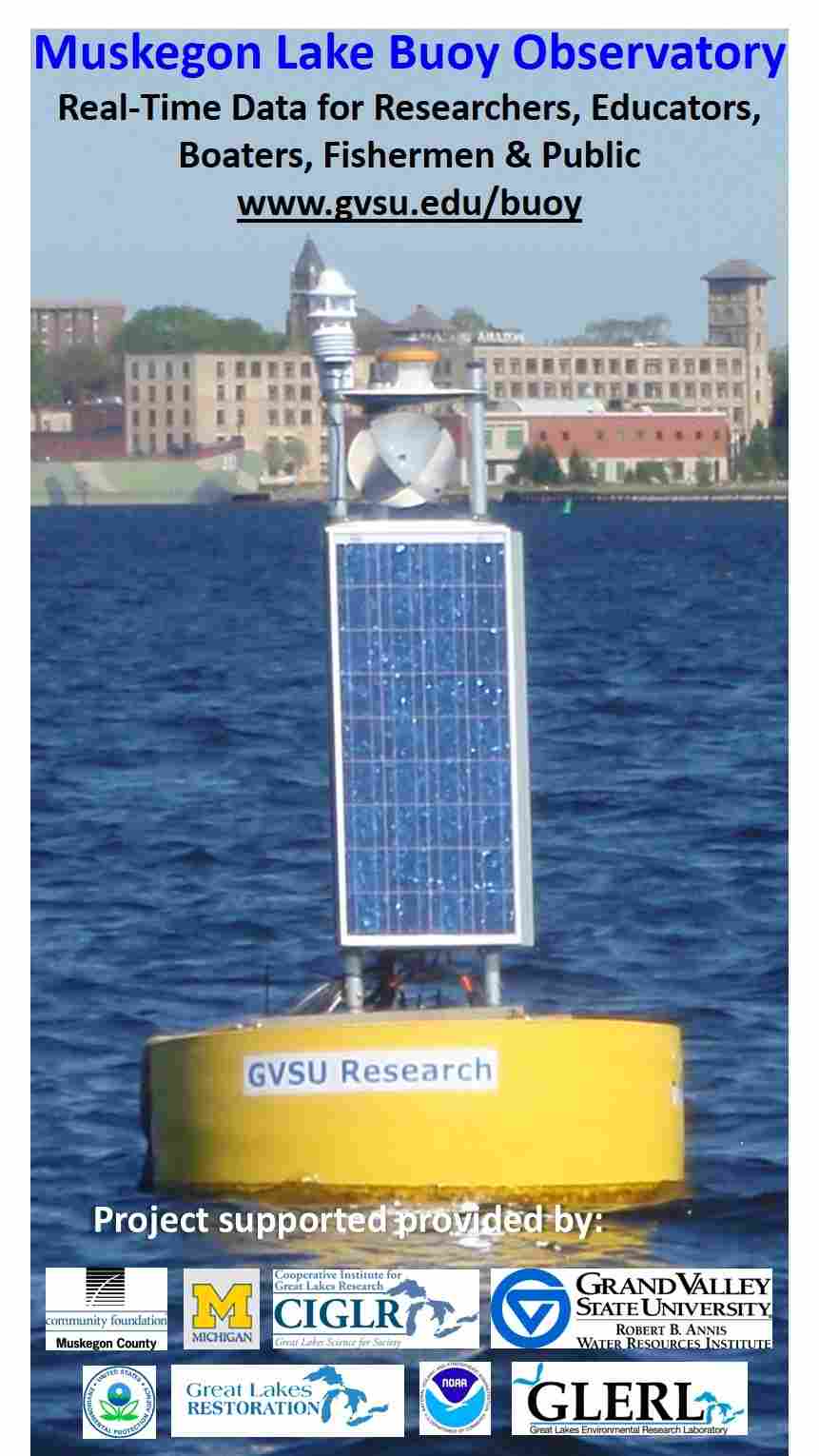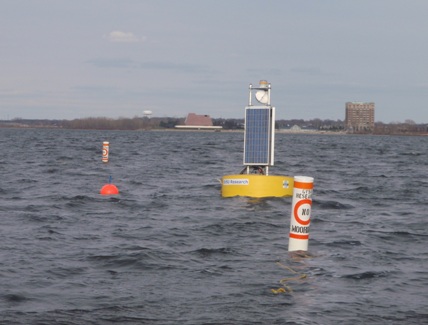Update: MiniMLO has been removed for the end of the 2025 season
Welcome to the Muskegon Lake Buoy website! From this site, you have at your fingertips current conditions and historic data from the Muskegon Lake buoy going back to 2011. The primary purpose of the buoy system is to help understand and manage this valuable water resource in the Muskegon area. However, data is openly accessible for everyone no matter what your interest:boating, fishing, wind surfing, paddle boarding, developing a lesson plan, working on a student project, doing lake research, or you just want to know the weather conditions in the area.
The buoy system is typically deployed on the lake from April to November, and some sensors may be in the lake year round. Water sensors measure over 13 parameters including temperature, oxygen, nutrients, light, pH, conductivity, algal pigments, bacterial pigments, and current speed and direction. Air sensors measure 8 parameters including temperature, wind, humidity, and precipitation. When the buoy system is deployed, data is shared through live data display, and web and regional observing networks for all to use.
Observatory data is available for researchers, community organizations, teachers, and students to learn about and assess the lake ecosystem. Research areas for this intensive data set are extensive and include:
- Monitoring water quality.
- Monitoring food web structure.
- Quantifying the significance of episodic storm events to the lake.
- Tracking algal blooms including harmful algal blooms.
- Influence of changing regional climate to water and carbon balance of the lake.
- Examination of the relationship of river discharge to in-lake fish recruitment success.
- Tracking water circulation patterns and sediments movements.
We encourage teachers at all grade levels to use the current and historical data in active learning projects related to learning of STEM, particularly learning objectives dealing with local water ecosystems, microbes, chemistry, photosynthesis, hydrology, etc.
Project Team
GVSU's Annis Water Resources Institute established the buoy-based observatory in Muskegon Lake in 2010. The project is managed by the Biddanda Lab under the direction of Bopi Biddanda, Ph.D. (principal investigator). Funding was initially provided from a grant from the US EPA Great Lakes Restoration Initiative, and is currently operated with support from NOAA-Great Lakes Environmental Research Laboratory, the University of Michigan-Cooperative Institute for Great Lakes Research, the Community Foundation for Muskegon County, the Consumers Energy Foundation, the Edison Innovation Foundation, and the NASA Michigan Space Grant Consortium.
Muskegon Lake Observatory "Symphony" data

Muskegon Lake Observatory buoy data can be plotted as if it were notes on a musician's score. Each year comprises a new measure, with differences between depths for each parameter creating a harmonic chord of sorts. Through over a decade of data collection, the song of Muskegon Lake has begun to emerge, singing a triumphant tune of gradual restoration.
"When ecologists can read numbers like musician's hear notes, then perhaps we will hear symphony where we previously only sensed cacophony."
~Victor Smetacek, 1986 Ophilia
Tango of Temperature and Dissolved Oxygen in Muskegon Lake
2017 Summer REU Undergraduate Tom Claffey created this video, visually illustrating how the water column of Muskegon Lake changes from spring to fall throughout the water column from 2011 to 2017. In the spring the water column is thermally stratified (same temperature top to bottom) which allows the whole lake to mix, making dissolved oxygen, which fish need to breathe, also the same top to bottom. In the summer, the upper waters warm while the bottom waters stay cold. This thermal stratification isolates the bottom waters from regular mixing and resupply of dissolved oxygen, which allows organisms like bacteria to use up much of the dissolved oxygen in the bottom waters, creating a condition known as "hypoxia". In the fall, when temperatures cool, the upper waters of the lake are more easily mixed with the bottom waters, replenishing dissolved oxygen to the whole water column.




